Date and Time of Visit: May 3, 2017, approximately 5:00 p.m.
This visit comes about a week after my last visit to the most beautiful village in Spain. Trujillo, which I will introduce here, is an old town in the center of Estremadura. It is located 46km east of Cáceres. It is located right in the middle of Lisbon and Madrid.
Some of the beautiful villages are sometimes listed in “Chikyu no Arukikata”, and this Trujillo is one of them.
It was a little difficult to find a parking lot, but there is a public parking lot on the south side of Plaza Mayor in the center of the city, a few minutes walk. There was also a restroom. If you are visiting by car, I think you should use this parking lot. It should be easy to get to and find as it is on the N521.
Above this parking lot is a park. You may want to park on the street around this park. I did so. However, this street parking, there is no parking meter around at all, and I ended up parking for free, but I did not know whether it was really good. In any case, it is better to park in the public parking lot of the fee though it costs money.
A brief history of Trujillo, as always.
This area has been inhabited since prehistoric times, but it didn’t start functioning as a city until the Roman colonial period. After that, it came under the rule of Muslims, and the castles and walls that we can see today were originally built during this period.
The most beautiful villages in France are the bastides of the Middle Ages, especially the villages of Aquitaine, many of which are fortified cities built in the struggle with the British, but the most beautiful villages in Spain are, after all, fortified cities built in the struggle with the Muslims.
Because of this history and the fact that some of the original streets still remain, Trujillo has been registered as a cultural heritage site in the province of Estremadura.

Another thing that makes Trujillo famous is that it has produced many reconquistadors (conquistadors, mainly referring to those who conquered the Latin American continent), such as Pizarro. There is a equestrian statue of Pizarro in the Plaza Mayor in the center of the village.

We arrived at 5 o’clock in the evening, but it was still bright enough. We went to the tourist information center in Plaza Mayor and asked for a map and a brief guide of the city. We started from the church facing the square. There was not a big feature in the interior, but it looked like a Christian church in South America, although I had never been there. I wonder if some kind of preconceived notion of the place where the Reconquistadors are from causes such feelings.

Next, we went up the hill behind the church. This was a very nice area with old cobblestone streets and small stalls on both sides of the streets.

We went to the Arab Castle, which is said to have been built by Muslims. It seemed that we could enter inside, but it seemed to be just an observatory, so we just kept walking around the castle ruins.


The view of the village from the castle ruins was wonderful.

Then we went to the church with the highest tower in the village.


Go to the top of the tower of course. The view from here is undoubtedly the most beautiful in the city.


By the way, I saw storks very often when I was driving in Alentejo in Portugal and Estremadura in Spain from there. I saw them often in Morocco, too.
Storks are still alive and well in Trujillo. They made a big nest on the tower of the church and lived there without any sense of incongruity. It’s a bird that you don’t see directly in Japan, so I was a little surprised at its size when I actually saw it.

The dry atmosphere of Estremadura, like an oasis in the desert and reminiscent of the landscape around Mexico, the ancient city of Trujillo was full of charm. We give it a 5-star rating (based on this site).


